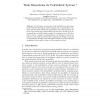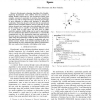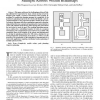1099 search results - page 149 / 220 » On the Complexity of Computing Evolutionary Trees |
CONCUR
2000
Springer
15 years 2 months ago
2000
Springer
Abstract. In this paper, we introduce weak bisimulation in the framework of Labeled Concurrent Markov Chains, that is, probabilistic transition systems which exhibit both probabili...
59
Voted
ICRA
2010
IEEE
14 years 8 months ago
2010
IEEE
Abstract— Kinodynamic planning algorithms like RapidlyExploring Randomized Trees (RRTs) hold the promise of finding feasible trajectories for rich dynamical systems with complex...
ICAC
2008
IEEE
15 years 4 months ago
2008
IEEE
We describe an automated method to generating models of an autonomic system. Specifically, we generate UML state diagrams for a set of interacting objects, including the extensio...
87
Voted
GECCO
2010
Springer
15 years 1 months ago
2010
Springer
The Baldwin Effect is a very plausible, but unproven, biological theory concerning the power of learning to accelerate evolution. Simple computational models in the 1980’s gave...
TROB
2008
14 years 10 months ago
2008
Abstract--This paper addresses the challenging problem of finding collision-free trajectories for many robots moving toward individual goals within a common environment. Most popul...



